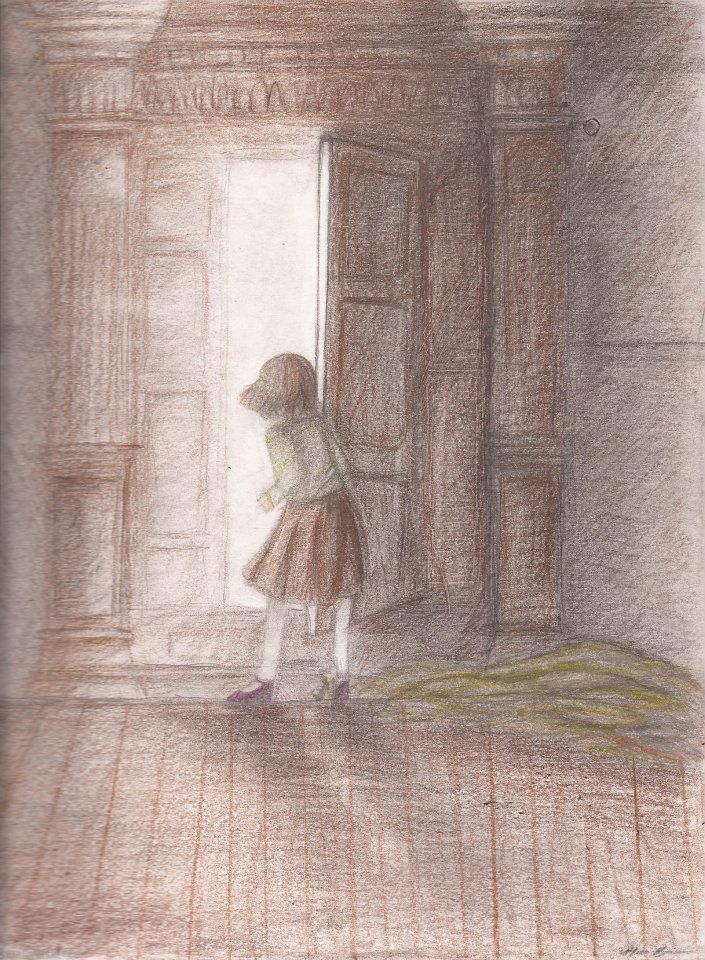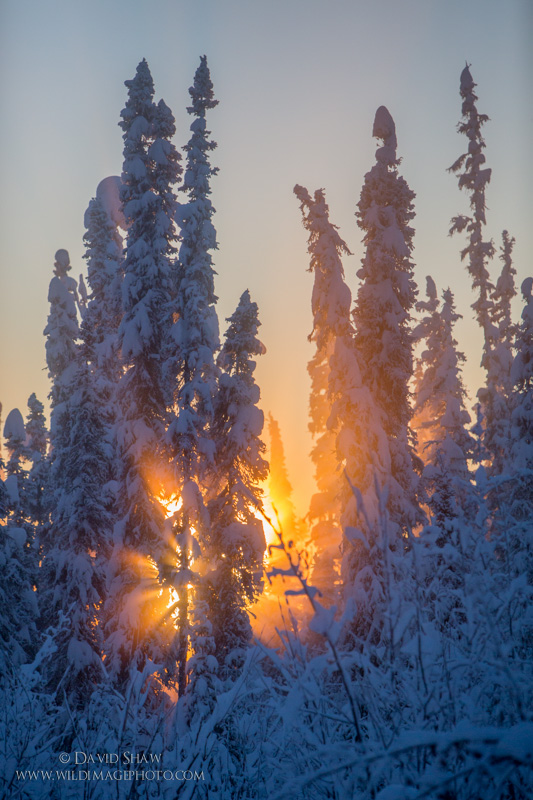Book review blog, Pages Unbound is hosting a month long C.S. Lewis Read Along! I am somewhat new to their blog, but everything I've read so far has been insightful, thoughtful, and engaging and I recommend you check them out and participate in their read-along. To kick things off, I'd like to look at The Lion, the Witch, and the Wardrobe, particularly (and since some of us are in the middle of this anyway) Narnia's transformation from winter into spring:
Our first introduction to Narnia's winter is wondrous, soft, and delicate. You'll remember Lucy does not just open the wardrobe door in one world and immediately enter another. She walks slowly through the wardrobe, going "further up and further in," if you will, and gradually enters Narnia. Throughout that time the winter of Narnia- the cold air, the bare trees, the powdery snow- are a quiet indicator of magic and otherworldliness. Once Lucy arrives in Narnia we're told "something cold and soft was falling on her. A moment later she found that she as standing in the middle of a wood at night time with snow under her feet and snowflakes falling through the air" (6-7). Rather than walk into an alarmingly and bitterly cold scene, Lucy enters a beautiful one. Winter, when it naturally occurs, can be delightful, elegant and purifying. And, though Lucy's journey through the wardrobe and Narnia itself is supernatural, the reader and Lucy alike assume the Winter is natural to the land. Thus Lucy walks into Narnia, "a little frightened but...inquisitive and excited as well" (7).
Our second impression of Narnia is through Edmund, whose experience with winter is more harsh right from the start. Even inside the wardrobe, Edmund's journey to Narnia is stressful and claustrophobic where Lucy's was enchanting and curious:
"He began feeling about for Lucy in the dark. He expected to find her in a few seconds and was very surprised when he did not. He decided to open the door again and let in some light. But he could not find the door either. He didn't like this at all and began groping wildly in the dark..." (25).
Soon enough, he finds himself in the middle of Narnia's wood. Here, Lewis does something very interesting. As we move out from Edmund and into the wider world of Narnia, the sky and trees become beautiful and serene:
"There was crisp, dry snow under his feet and more snow lying on the branches of the trees. Overhead there was a pale blue sky, the sort of sky one sees on a fine winter day in the morning. Straight ahead of him he saw between the tree trunks, the sun just rising, very red and clear. Everything was perfectly still."
We glimpse the parts of Narnia that the winter cannot touch- the light of the sun, a beautiful morning. This is a moment even more beautiful than the one Lucy first encounters. But notice the sudden turn as we narrow back on Edmund:
"Everything was perfectly still, as if he were the only living creature in that country. There was not even a robin or a squirrel among the trees, and the wood stretched as far as he could see in every direction. He shivered." (26).
The stillness of winter is no longer serene, but eerie and uncanny. Even the bright, red sunrise cannot kee
p Edmund from shivering. Narnia is "a strange, cold, quiet place"(26) for him, and rightly so. As Mr. Tumnus tells us, the White Witch keeps it "always winter and never Christmas" (16). Keep in mind, however, that the 'never Christmas' remark means much more than merely not receiving presents. In a relevant post on The Hog's Head John Patrick Pazdziora says, "The White Witch keeps Narnia forever in the darkest night of all the year. It is a time of hardship and peril... but without the consolation and grace of the solstice and Christmas." Christmas and Father Christmas have a presence in Narnia that is much more real and natural than we would expect (when we meet Father Christmas, for instance he is described as being the real Father Christmas, of which our own world can only emulate). The stillness and strangeness that Edmund feels in Narnia is the effect of an unnatural winter. Narnia is both literally and figuratively frozen and Edmund, who is certainly the 'coldest' Pevensie, is both less able to notice Narnia's goodness and more sharply aware of its evil.
When Aslan returns to Narnia the Witch's magic begins to weaken. Winter in Narnia slowly comes to an end. But the wonderful thing about the transformation from winter into spring in Narnia is that it happens simultaneously with Edmund's own transformation from a selfish and proud person into a humble one. As Edmund travels with the Witch the snow becomes unbearable, "oh how miserable he was!" (110). Even when it eventually stops falling the snow underneath the sled is "everlasting" and doesn't let up until Edmund witnesses the Witch's evil firsthand:
"She had waved her wand and where the merry party had been there were only statues of creatures (one with its stone fork fixed forever half way to its stone mouth) seated round a stone table on which there were stone plates and a stone plum pudding...And Edmund for the first time in this story felt sorry for someone besides himself" (113).
and then, immediately, the snow lets up, Narnia warms, and life returns:
"And soon Edmund noticed that the snow which splashed against them as they rushed through it was much wetter than it had been all last night. At the same time he noticed that he was feeling much less cold...A strange, sweet, rustling, chattering noise-and yet not strange, for he knew he'd heard it before...it was the noise of running water...chattering, murmuring, bubbling, splashing..." (114)
Edmund warms up from the inside out. Once he feels empathy for others, he is no longer alone. And the land that had seemed so endless and eerie to him before is now beautiful and in harmony with the natural forest:
"Soon wherever you look you saw dark green of firs or black prickly branches of bare oaks and beeches and elms. Then the mist turned from white to gold...Shafts of delicious sunlight struck down onto the forest floor and overhead you could see a blue sky between the tree-tops. Soon there were more wonderful things happening..." (116).
Edmund is not just witnessing the coming of spring, he is truly enjoying it. He, like Narnia itself becomes rejuvenated and enlightened.
Lewis, C.S. The Lion, the Witch and the Wardrobe. New York: Macmillan
Publishing Company. 1950. Print






You bring up a lot of good points! I'm not sure I've noticed before how Edmund's changes are connected to those in the weather. I also really like your exploration of Lucy's and Edmund's different reactions to the same place and situation. To some degree, we really do notice what we want to notice in our surroundings.
ReplyDeleteThanks! I didn't have any intention of comparing Lucy and Edmund when I started this, but it was one of those things I couldn't help noticing this time around. And yes, I think so too- sometimes we notice things we want to notice. In fact, that's what happens to Uncle Andrew in The Magician's Nephew when he can't understand the language of the animals- a part of him simply doesn't want to.
ReplyDelete:)
Fantastic post! I love your exposition of the way Lewis portrays Edmund's view of Narnia, and of how we see it through and beyond him. Very cool. :)
ReplyDeleteThanks! :)
ReplyDeleteWhat a brilliant post, this is one of my favourite books! I especially enjoyed the parallels between Edmund's and Narnia's 'thawing out', I'd never seen the connection specifically in relation to him before, it was enlightening!
ReplyDeleteAfter studying WW2 at school I started to think a bit more critically about the children as a group and their connections to the seasons: at the beginning of the book they have been evacuated and are bored and frustrated, having, they believe, nothing to do. At the same time Narnia is in the depths of winter, everything is dead and on hold, and, as you said, what with it being 'always winter and never christmas' it is the most depressing and dark time of year, which I think could also represent their feelings about the war, finding it hard to see it ending any time soon and wondering what on earth to do with themselves.
When Spring comes to Narnia, they are all finding inner strength in one way or another, a power that they haven't been able to feel being children, evacuees, and war-torn from their homes and families. I think their time in Narnia empowers them despite being in a powerless situation in England, and perhaps offers them hope, too.
(On a side note: the description of the winter woods is truly magical, and that scene where the White Witch gives Edmund Turkish Delight was so evocative that I *had* to try it, it sounded like the most delicious thing on the planet! I was gutted when I didn't like it...I actually felt a little bit betrayed :/ )
Thank you!! I'm glad you enjoyed it :)
ReplyDeleteI really like your connection between the winter of Narnia and the 'winter' of the war. That's something very prevalent in the novel, but somehow not something I've fully acknowledged before! Everything IS sort of on hold in England and in a way, it's not just the wardrobe that helps the Pevensie's escape from the real world, but the country and professor's house as well. The house protects them and in turn, they protect Narnia.
And I think the children do grow in Narnia in a way they really couldn't in the real world. I quote this all too often, but I just always find it so applicable:
"Since it is so likely that (children) will meet cruel enemies, let them at least have heard of brave knights and heroic courage" -C.S. Lewis
(Oh! How betrayed I felt with turkish delight as well!)